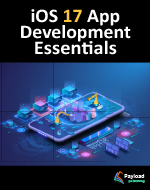Difference between revisions of "Kindle Fire Development Essentials"
From Techotopia
| Line 14: | Line 14: | ||
# [[Introduction to Kindle Fire App Development Essentials]] | # [[Introduction to Kindle Fire App Development Essentials]] | ||
| + | #* [[Introduction to Kindle Fire App Development Essentials|About Kindle Fire App Development Essentials]] | ||
| + | #* [[Introduction to Kindle Fire App Development Essentials|Downloading the Code Samples]] | ||
| + | #* [[Introduction to Kindle Fire App Development Essentials|Feedback]] | ||
| + | #* [[Introduction to Kindle Fire App Development Essentials|Errata]]<br><br> | ||
| + | # [[An Overview of the Kindle Fire]] | ||
| + | |||
| + | |||
| + | |||
# [[An Overview and History of the Kindle Fire]] | # [[An Overview and History of the Kindle Fire]] | ||
#* [[An Overview and History of the Kindle Fire|The History of the Kindle Fire]] | #* [[An Overview and History of the Kindle Fire|The History of the Kindle Fire]] | ||
Revision as of 19:19, 15 May 2013
| Table of Contents | Next | |
| An Overview and History of the Kindle Fire |
<google>BUY_KINDLE_FIRE</google>
Table of Contents
- An Overview and History of the Kindle Fire
- Setting Up a Kindle Fire Android Development Environment
- Creating a Kindle Fire Android Virtual Device (AVD)
- Creating an Example Kindle Fire Android Application
- Testing Android Applications on a Physical Kindle Fire Device
- An Overview of the Android Debug Bridge (adb)
- Configuring the adb to Detect a Kindle Fire Device
- Mac OS X Kindle Fire adb Configuration
- Windows Kindle Fire adb Configuration
- Configuring the adb_usb.ini File
- Configuring the Google USB Driver Package
- Installing the Google USB Device Driver
- Restarting the adb Server
- Linux Kindle Fire adb Configuration
- Identifying the Linux USB Device
- Editing the 51-android.rules File
- Modifying the adb_usb.ini File
- Restarting the adb Server
- Testing the adb Connection
- Manual Selection of the Application Run Target
- An Overview of the Kindle Fire Android Architecture
- The Anatomy of an Android Application
- Understanding Android Application and Activity Lifecycles
- Handling Android Activity State Changes
- Android Activity State Changes – An Example Application
- Saving and Restoring the User Interface State of an Android Activity
- Understanding Android Views, View Groups and Layouts
- Designing an Android User Interface using the Graphical Layout Tool
- The Android Graphical Layout Tool
- A Graphical Layout Tool Example
- Adding an XML Resource File to the Project
- Editing View Properties
- Using the View Properties Sheet
- Creating a New Activity
- Adding the New Activity to the Manifest File
- Running the Application
- Manually Creating an XML Layout
- Using the Hierarchy Viewer
- Creating an Android User Interface in Java Code
- An Overview and Example of Android Event Handling
- Android Touch and Multi-touch Event Handling
- Android Gesture and Pinch Recognition on the Kindle Fire
- The Android Gestures Builder Application
- The GestureOverlayView Class
- Detecting Gestures
- Identifying Specific Gestures
- Adding SD Card Support to an AVD
- Creating a Gestures File
- Extracting the Gestures File from the SD Card
- Creating the Example Project
- Designing the User Interface
- Loading the Gestures File
- Registering the Event Listener
- Implementing the onGesturePerformed Method
- Testing the Application
- Configuring the GestureOverlayView
- Intercepting Gestures
- Detecting Pinch Gestures
- A Pinch Gesture Example Project
- An Overview of Android Intents
- Android Explicit Intents – A Worked Example
- Creating the Explicit Intent Example Application
- Designing the User Interface Layout for ActivityA
- Creating the Second Activity Class
- Creating the User Interface for ActivityB
- Adding ActivityB to the Application Manifest File
- Creating the Intent
- Extracting Intent Data
- Launching ActivityB as a Sub-Activity
- Returning Data from a Sub-Activity
- Testing the Application
- Android Implicit Intents – A Worked Example
- Creating the Implicit Intent Example Project
- Designing the User Interface
- Creating the Implicit Intent
- Adding a Second Matching Activity
- Adding the Web View to the UI
- Obtaining the Intent URL
- Modifying the MyWebView Project Manifest File
- Installing the MyWebView Package on a Device
- Testing the Application
- Android Broadcast Intents and Broadcast Receivers
- An Overview of Broadcast Intents
- An Overview of Broadcast Receivers
- Obtaining Results from a Broadcast
- Sticky Broadcast Intents
- The Broadcast Intent Example
- Creating the Example Application
- Creating and Sending the Broadcast Intent
- Creating the Broadcast Receiver
- Configuring a Broadcast Receiver in the Manifest File
- Testing the Broadcast Example
- Listening for System Broadcasts
- A Basic Overview of Android Threads and Thread handlers
- An Overview of Android Started and Bound Services
- Implementing an Android Started Service – A Worked Example
- Android Local Bound Services – A Worked Example
- Android Remote Bound Services – A Worked Example


